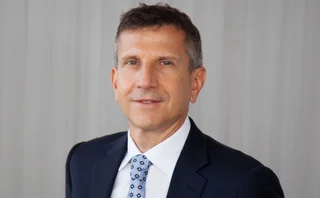
Lifetime achievement award: Wilson Ervin
After helping Credit Suisse through the crisis without state support, Wilson Ervin stepped down as chief risk officer. Since then, he has spent his time looking for a way out of the too-big-to-fail problem - and regulators think he has found it

The aftermath of the financial crisis has been a boom time for ideas, but most of those that have got anywhere have been small – incremental changes or refinements. Wilson Ervin, New York-based vice-chairman of Credit Suisse, is behind one of the few big ideas to have taken root – bail-in – the notion that a major bank collapse could be resolved by forcing losses onto its bondholders.
It still has its critics, but regulators in Europe and the US have put bail-in at the heart of attempts to end the too-big-to-fail problem, and its proponents compare it to the introduction of deposit insurance or the advent of central banking as a historic, landmark change – something genuinely new, and hugely powerful. For Ervin himself, who has spent much of the past four years fleshing out and promoting the idea, after stepping down as Credit Suisse’s chief risk officer (CRO), it is a chance to make a difference.
“If I ask myself why I care about coming into the office every day – after 32 years – what excites me about the job now is thinking I may have a small part to play in something that is pretty meaningful, something that actually makes the world a little bit better,” he says.
The story begins with a phone call, just after the stock market closed on Friday, September 12, 2008 – three days before news broke that Lehman Brothers was bankrupt, and a month before the US Treasury stepped in to prop up the rest of the industry with $245 billion of public funds. The call was from the office of Credit Suisse’s chief executive, Brady Dougan, and the message was simple – Dougan and Ervin were going to the offices of the Federal Reserve Bank of New York.
The two men bundled into a car to take them the three miles downtown from Credit Suisse’s grand old 11 Madison Avenue headquarters. Neither knew what they were walking into, but they had some guesses, which became clearer as – one by one – they were joined at the Fed by chief executives and CROs of the other big banks.
There was kind of a moral dimension to this as well, an emotional dimension
“There were obviously a tonne of rumours in the market. There was a lot of probing of how strong or how weak Lehman was. I had a sneaking suspicion that the topic of contributing money to a rescue might come up, which might get expensive. As we were moving into the room – I think we were the first guys there – I thought, ‘This is going to be interesting, but I wouldn’t mind sitting a few spots away from the action’,” Ervin recalls.
That didn’t go so well. He ended up sitting next to New York Fed president Tim Geithner and opposite the secretary of the Treasury, Hank Paulson. Paulson set the stage. The aim was to avoid a messy conclusion to the slow demise of Lehman Brothers, which had seen its stock fall from its 2007 record high of $86 to less than $5 in the preceding days, but the US government was not willing to provide a guarantee to an acquirer, as it had done to the tune of $29 billion when JP Morgan bought Bear Stearns in March 2008. Instead, the industry would have to find a solution.
“We all understood the hand of history was there. Paulson and Geithner made it abundantly clear this was a situation of national importance. I remember Paul Calello [then head of the investment bank at Credit Suisse] discussing this, I think on Saturday, saying, ‘It’s important to remember what goes on here. This is not just a story for tomorrow’s newspapers. What happens this weekend will have huge implications for the whole industry, for how the government responds, for how history will treat us’,” he says.
As the weekend wore on, bankers came and went, some working at the Fed overnight, others being ferried to and from their homes to shower and grab a few hours of sleep. Separate groups formed to tackle specific parts of the problem. Talk turned into numbers and diagrams on notepads and flipcharts. “There were a couple of structured meetings per day and then there was more informal time. In some ways, it was quite strange: we were in this large room at the Fed, and it was the only time I’ve ever seen all the bank chief executives physically in one spot. You’d see Gary Cohn and Lloyd Blankfein with a couple of the key Goldman guys over in one corner. You’d see Vikram Pandit and the Citi guys in another. There was John Mack and some folks from Morgan Stanley, Jamie Dimon from JP Morgan, John Thain for Merrill Lynch. When you saw those groups of people representing all the major powers of Wall Street, it felt a bit unreal even at the time, a bit like a film,” says Ervin.
The assembled banks agreed to bid as a consortium for Lehman’s bad assets – a version of the so-called SpinCo plan that executives at Lehman Brothers had come up with earlier that month – but it was complex, and it still needed an acquirer for the bank’s good assets. When Barclays pulled out of the running and Bank of America ruled out a bid, SpinCo was pointless.
Ultimately, the weekend was a failure. Lehman Brothers filed for bankruptcy, ushering in the darkest days of the crisis – paralysing fear, all-pervading uncertainty, the spectre of complete systemic collapse – and forcing US taxpayers to underwrite the industry from that point on.
“Leaving the Fed on Sunday was a profound experience. You know you’re at a moment that’s making history – but you also know it’s going to be ugly. You don’t know what’s going to happen exactly, you just know it’s going to be a rough ride. This was a breakdown of the financial system and it was something that troubled me in a lot of ways. I was frankly surprised there weren’t better contingency plans. People improvised pretty well over the weeks that followed, but there wasn’t really a decent plan b,” says Ervin.
“It was one of those things that also hits you in the gut. It should hit you if you’ve been in the business. I’ve been in the banking business for a long time; this is my profession. We went from being people who were mostly respected, thought to be smart and able to fix things, to being unable to find a solution to our own problems. It was embarrassing. So there was kind of a moral dimension to this as well, an emotional dimension, that nags you and drives you to think harder about what happened and how it could be fixed,” he adds.
Ervin stayed in the CRO’s role at Credit Suisse until June 2009. At that point, it felt as though the bank had weathered the storm, and markets were beginning to mend, he says. But although Credit Suisse came through the crisis in good shape, and was one of very few banks not to need state support, the experience was exhausting. Ervin has two daughters, now aged eight and 10, but from mid-2007 until mid-2009, he says he was too much of an absentee parent, – rarely seeing them during the week and working most weekends.
The experience of the Lehman weekend also continued to bother him. He wanted to work on the problems that had been revealed during those intense, frustrating 48 hours at the New York Fed, and knew he would need to change his job. Dougan made sure he didn’t also have to leave the bank. “Brady has let me mostly define my own path here. He’s given me input, but also a lot of freedom to pursue this, which has been immensely helpful,” Ervin says.
It was the start of an engaging, enjoyable four-year period. Ervin was given an office on the quiet, dark-wood-panelled 27th floor of the Madison Avenue building, alongside the other senior New York-based executives. It’s a little like the space one of his professors at Princeton, his alma mater, might have occupied – stuffed with books and folders. The big difference is the plaques and logos that nod to Ervin’s long career with Credit Suisse and its 1990 US investment banking acquisition, First Boston, where he started out as an analyst.
In those executive offices, Ervin started to thrash out some answers to the Lehman Brothers collapse, talking his ideas through with Dougan and Calello, who died of cancer in November 2010. The same kind of conversations were taking place all over the world, of course, at central banks and supervisors, in bank boardrooms, on trading floors, in bars and living rooms. One of the advantages Ervin and co enjoyed was the experience of the Lehman Brothers collapse – they had seen, first-hand, the failed attempt to resolve a big bank and slowly, one of the ideas they had briefly toyed with that weekend started to take on a life of its own.
“During that weekend, I remember talking with Brady and Paul about whether there were any other big options that might work. This was probably late on Saturday night when we were too exhausted to think straight. We talked about what we could do if this was a corporate restructuring – how we would have better options. We wondered if there might be some way to do that and made a few calls to explore it. But we couldn’t see any practical way to do anything fast enough. There were lots of more immediate problems, so we put that idea in a box pretty quickly and pushed it to the back of the shelf,” he says.
Ervin and Calello dusted the idea down in the closing months of 2009 – also discussing it with Dougan and some of the bank’s legal and restructuring experts. The question they kept asking was why a bank insolvency was so terrifying and intractable, while a corporate bankruptcy was almost mundane, and whether there was any way to make a bank failure similarly boring. As is the case with a corporate restructuring, the answer was to contain the pain, rather than spread it around, but to do it much more quickly, and because that basic approach contrasted so starkly with a public bail-out, they started calling it a bail-in.
“We were just trying to come up with a short way to express the idea. We wanted to get across the notion that this was a strategy that used the intrinsic resources of the firm – the opposite of a bail-out. We kind of made it up. I think it was the first time the term had been used in this context,” says Ervin.
In late January 2010, they went public with the idea in a co-authored piece for The Economist called From bail-out to bail-in. It bore the stamp of the Lehman weekend, pointing out that the bank was estimated to have $25 billion in unrealised losses immediately prior to its bankruptcy, which mushroomed to $150 billion of shareholder and creditor losses as the bank was wound up. If regulators could have assigned those losses to equity and debt investors, while also writing the liabilities down sufficiently to recapitalise the bank, and if they had the power to do it quickly, in the space of a weekend, no-one would need to fear bank insolvency. “Wouldn’t that be a Monday morning worth fighting for?” the article asked, in conclusion.
It was just a 1,000-word piece, a rudimentary sketch of the resolution framework that has since been endorsed by the Federal Deposit Insurance Commission (FDIC) and, last month, by the European Union, but it was a big idea and, more importantly, a good idea.
“We got great reaction. Glenn Hubbard, who had chaired the president’s Council of Economic Advisors, and Doug Elliot from the Brookings Institute wrote nice reviews about it. We got a number of calls from the Bank of England, which was very interested in this topic and had been spending a lot of time exploring concepts in this direction. Most of the guys that were active in this area seemed to be intrigued, and some thought it could be truly transformative – maybe even the key to the lock,” he says.
Others can testify to that. John Dugan, a partner with law firm Covington & Burling in Washington, DC, says the bail-in idea – and its originator – first came to his attention in 2010, while he was Comptroller of the Currency.
“I started hearing about Wilson while I was still with the government, because Credit Suisse was the first institution to really start trying to get the attention of regulators on this idea of an orderly reorganisation and recapitalisation of a bank. It clearly attracted the interest of the Bank of England and it began to really push hard for it as a way to deal with the too-big-to-fail problem,” he says.
Richard Thornburgh, vice-chairman at private equity firm Corsair Capital and chair of the Credit Suisse board risk committee, recalls a 2011 meeting between committee members and the Bank of England, the UK’s Financial Services Authority and the New York Fed. “The topic of discussion was something quite different but, at the end of the meeting, they went out of their way to compliment Credit Suisse for the role it had played in helping establish bail-in as a viable concept. That was a mark of the work Wilson had done,” he says.
It needed a lot more work, of course. Ervin continued to push the idea in meetings with regulators, with academics and with bankers on both sides of the Atlantic. But now, others also wanted to dig into it and thrash out the details. Gradually, it became more than an idea; it became a policy.
“It wasn’t until late 2011 that the idea seemed to find real traction. That was when the Financial Stability Board (FSB) included bail-in as a key attribute for solving too-big-to-fail – a core requirement that all the Group of 20 (G-20) nations would have to sign up to. A few months later, Marty Gruenberg [then the acting chairman of the FDIC, and now its chair] gave a speech saying the FDIC was going to use bail-in-style recapitalisation as its primary resolution strategy. That was huge – initially, it had not been in favour. Also, in early 2012, the European Commission put a strong bail-in section into its draft directive on bank recovery and resolution, and got a lot of flak for it. It showed a lot of courage to do that in the midst of the eurozone crisis, but it saw a need for something fundamental to break the bank-sovereign feedback problem. It realised that using government capital to backstop failing banks was not a great solution any more – in fact, it had become part of the problem,” Ervin says.
To Dugan, the speed with which bail-in has become an established part of post-crisis policy is something special. “It’s been remarkable. This whole paradigm didn’t exist three years ago and now it is part of the bedrock. It is so rare to see an idea of this magnitude take root in such a practical way and get adopted by both regulators and industry as a constructive, positive thing. I think Wilson was absolutely at the forefront of all of that.”
Ervin himself says a lot of the credit belongs elsewhere. He picks out Calello and Dougan at Credit Suisse, for starters. Academics such as Darrell Duffie and Anil Kashyap – finance professors at Stanford University and the University of Chicago, respectively – took an interest in the concept and gave it some early oxygen, he says. Randall Guynn, a partner at law firm Davis, Polk & Wardwell, looked at the legal challenges. Among regulators, Ervin picks out Jim Wigand, who retired from his role as head of the FDIC’s office of complex financial institutions in September, but did much to combine bail-in with the agency’s established bank wind-down procedures. He also highlights the role of Mark Carney, chair of the FSB, and Paul Tucker, former deputy governor of the Bank of England, who left that post in mid-October.
“Paul’s role in the official sector has been enormous – getting the FSB behind this, getting the G-20 behind this. He not only helped develop the conceptual architecture, he also understood the practical issues in moving this forward internationally. If you’re talking about energy and effectiveness in solving the too-big-to-fail issue, Paul’s contribution has been pretty gigantic,” he says.
In a way, Ervin’s involvement in all this should not be a surprise. Throughout his long career at Credit Suisse, he has constantly looked for new, often intellectual, challenges. He didn’t always have the freedom to pursue them, as shown by an extract Ervin reads from one of his performance reviews, written in 1996, while running US corporate marketing at Credit Suisse Financial Products: “Wilson spends too much time on problems he finds interesting and not enough time on blocking and tackling.” Today, Ervin concedes his boss had a point.
His time as CRO, responsible for a department of roughly 1,000 people globally, offered both types of problems. Ervin used the period leading up to the crisis to take stock of the bank’s businesses as part of a strategic review mandated by the executive board. It left him and other executives with a clear picture of how the bank was making its money. It also highlighted weak spots, and gave the CRO plenty to worry about.
“I remember sitting down with some of the more thoughtful senior guys in the residential mortgage business and going through some what-if scenarios. We’d had house price appreciation in the US for over 50 years. This accelerated in the mid-2000s, and you started hearing these crazy stories, get-rich-quick ads on the radio. So we asked what would happen if there was a nationwide reversal of X%, and one of the guys in the business said, ‘Well, that can’t happen. That would destroy the balance sheets of a lot of Wall Street’,” Ervin says. “There was a pause, and we both looked at each other, and then we said ‘That’s not a very good reason, is it?’ As we talked through this stuff, we realised how dependent the industry had become on housing appreciation and huge liquidity, and as Stein’s law says, ‘If something can’t go on forever, it will stop’.”
The bank tackled its own exposure in a number of ways. It declined some big deals, even in core franchises such as high yield or mortgage-backed securitisations, and clamping down on inventory. Jim Healy, then the bank’s head of fixed income, played a part – getting out of business including the underwriting of some structured credit products – while the bank’s chief credit officer at the time, Bob O’Brien, steered it away from the monoline insurers that would cost other banks dearly. In addition, Ervin and Calello put on some macro hedges in 2006 and 2007 – primarily buying protection on credit default swap indexes.
These steps had Dougan’s backing, but were not popular with everyone, especially as the new limits and hedge costs were pushed down to individual businesses. In retrospect, Ervin wishes the bank had gone further, but it was enough to make Credit Suisse a safe port throughout the ensuing chaos.
Equally important were the efforts Ervin and the rest of the management team made to keep the board informed, says Corsair Capital’s Thornburgh, who has been a member of Credit Suisse’s board risk committee since 2006. In particular, stress test results helped prepare the bank’s directors for what was to come, he says.
“We always knew how much exposure we had to emerging markets, leveraged lending, commercial and residential mortgages, so when the hits happened, we understood how bad things could be. That’s what allowed the board to sail through crisis with a lot of confidence in the management team. There were a lot of places where, frankly, it came as a surprise – and when you’re surprised you try to find fault. At Credit Suisse, that was never an issue,” he says.
Only users who have a paid subscription or are part of a corporate subscription are able to print or copy content.
To access these options, along with all other subscription benefits, please contact info@risk.net or view our subscription options here: http://subscriptions.risk.net/subscribe
You are currently unable to print this content. Please contact info@risk.net to find out more.
You are currently unable to copy this content. Please contact info@risk.net to find out more.
Copyright Infopro Digital Limited. All rights reserved.
As outlined in our terms and conditions, https://www.infopro-digital.com/terms-and-conditions/subscriptions/ (point 2.4), printing is limited to a single copy.
If you would like to purchase additional rights please email info@risk.net
Copyright Infopro Digital Limited. All rights reserved.
You may share this content using our article tools. As outlined in our terms and conditions, https://www.infopro-digital.com/terms-and-conditions/subscriptions/ (clause 2.4), an Authorised User may only make one copy of the materials for their own personal use. You must also comply with the restrictions in clause 2.5.
If you would like to purchase additional rights please email info@risk.net
More on Awards
Environmental products house of the year: ENGIE
ENGIE is driving change in energy transition, with a strong focus on renewable energy and the liberalisation of power markets in Apac, which presents significant long-term growth opportunities. In recognition of its efforts, ENGIE GEMS has been named…
Natural gas/LNG house of the year: ENGIE
ENGIE continues to expand its services to better serve firms in Apac dealing with the challenges of energy risk management and supply
FRTB management solution of the year: Bloomberg
Amid the diverging timeframes and complex requirements of FRTB, Bloomberg offers a consistent, comprehensive and customisable solution for Apac banks preparing for implementation
Newcomer of the year: Topaz Technology
Jon Fox and former colleagues formed Topaz Technology in 2015. Having seen many different systems and, in some cases, written and built a few themselves, there was always something missing, leading them to build a system that unifies risk reporting and…
Technology vendor of the year: Murex
As a technology vendor, Murex places adaptability front and centre of everything it does, constantly enriching its MX.3 platform to ensure institutions can respond to new market opportunities as soon as they spot them
Currency derivatives house of the year: Deutsche Bank
Asia Risk Awards 2024
Interest rate derivatives house of the year: Standard Chartered Bank
Asia Risk Awards 2024
Derivatives house of the year, Taiwan: CTBC Bank
Asia Risk Awards 2024








